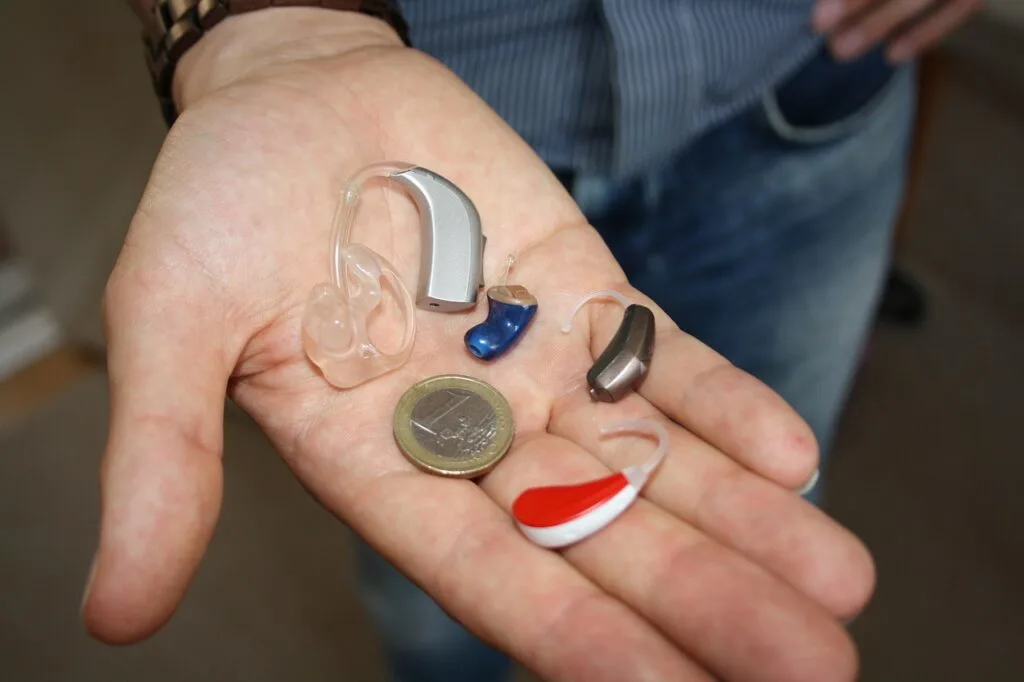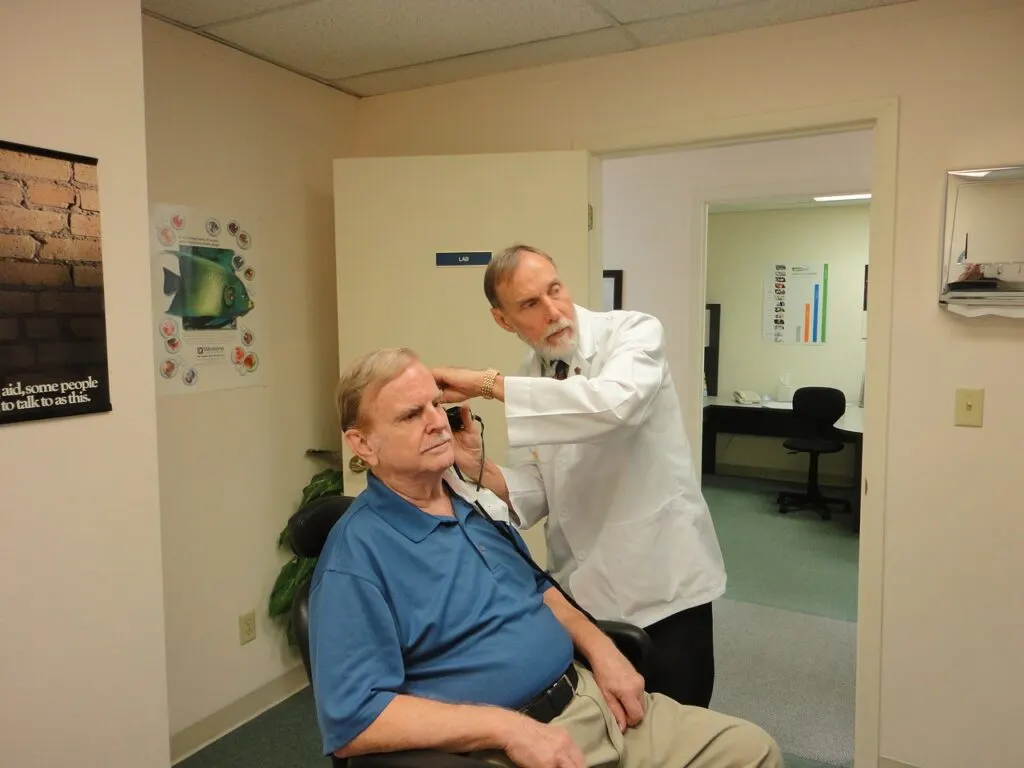Whether you’ve seen a few signs you need your hearing checked or have been living with hearing loss for a while, hearing aids generally come into the picture sooner or later. In fact, nearly 30 million Americans wear one, and each is configured to the individual patient’s needs. However, when first discovering you need a hearing aid, lots of questions come to mind including worries about choosing the right hearing aid.

Since hearing aids do not restore your hearing (they use technology to amplify certain sounds you have difficulty hearing), they require learning and training to make them effective. When evaluating hearing aid options, you need to consider the type of hearing loss you have, your lifestyle needs, and what features are available in different models before making a decision.
In this article, we’ll tell you everything you need to know about choosing the right hearing aid for your needs.
How do hearing aids work?
Before you start your search towards choosing the right hearing aid, it helps to have an understanding of how they work. These days, all hearing aids are digital, meaning they convert sound into data and interpret it. All types of digital hearing aids use the same basic technology to carry sounds from your environment to your ear:
- First, a small microphone (or microphones) captures the sound from your environment.
- Next, a computer chip with an amplifier converts the sounds into digital code.
- The computer chip then analyzes the sound level around you and your hearing abilities and then converts it back into amplified sound waves at a specific level.
- Finally, a receiver delivers those amplified sounds to your ear.
- The rechargeable battery powers the device.
Digital hearing aids are also programmable, meaning your hearing healthcare professional can adjust the sound levels from the device to best match your needs.
Types of Hearing Aids
Some people don’t want to wear hearing aids, and that’s mostly because of the stigma attached to those older oversized, bulky models. However, today’s hearing aids are much more discreet and comfortable.
When an audiologist from HearCanada, sets you up with a new hearing aid, they will take into account your lifestyle needs and hearing loss type, as well as the different styles of hearing aid and features that are available. This information will help make choosing the right hearing aid much easier.

Here’s an overview of the different kinds of modern hearing aids.
Completely-in-Canal (CIC)
CIC hearing aids are the smallest and least visible. They’re molded to fit deep inside the ear canal, making them barely noticeable to passersby. Aesthetically, when it comes to choosing the right hearing aid, most people prefer CIC hearing aids because they don’t impact the wearer’s appearance at all.
Since they’re the tiniest, they’re also the least likely to pick up residual noises like wind or the sound of a fan. However, they do have a few downsides:
- Since CIC hearing aids are small, they have tiny batteries that don’t last as long.
- CICs don’t always have the power to amplify louder sounds effectively, so they may not be the best choice for people with severe hearing loss.
- They don’t include extra features like volume control and directional microphones.
- Earwax builds up around CIC hearing aids more quickly.
In-the-Canal (ITC)
ITC hearing aids are another popular choice because they’re custom-molded to fit the outer ear canal shape. This makes them super easy to insert and take out. Like, CICs, they fix mild to moderate hearing problems. They have a few more features than CICs, including volume control, improved microphones, feedback cancellation, and longer battery life.
Compared to other hearing aids, ITCs are still relatively small; most people won’t see them unless they’re right next to someone wearing one. Of course, this creates the same disadvantage as CICs. When choosing the right hearing aid you may also want to consider the fact that even though ITC’s are small, and even though they have more features, adjusting them is difficult because of their size.
In-the-Ear (ITE)
An ITE hearing aid is larger than its CIC and ITC counterparts, but they amplify sound more effectively. ITEs come in full-shell or half-shell models that fit into the whole outer ear or just part of it. ITEs are good for people with mild to severe hearing loss because their shape allows for more powerful amplification.
Thanks to their slightly larger size, ITEs feature directional microphones that help reduce background noise and focus on sounds coming from the front, along with volume control. They also have a slightly bigger battery than CICs, so they last longer.
ITE hearing aids are less discreet than CIC or ITC models, as they’re visible to people nearby even from a distance. They also pick up excess noise more frequently. However, they’re easier to handle and adjust because they’re bigger and have more features.
Behind-the-Ear (BTE)
Although most people prefer something less noticeable when choosing the right hearing aid, larger models often have more benefits. BTE’s or behind-the-ear aids are much larger and more noticeable because they sit on the top of the ear. They have a tube that connects to a custom earmold inside the ear canal.
BTEs are also more powerful than other hearing aids because of their larger size; this means they can help people with mild to profound hearing loss. BTEs also come with extra features like volume control, feedback cancellation, and directional microphones.
They’re also the easiest to handle and adjust. Since their battery compartment is larger, they have a longer battery and far more options for rechargeable batteries.
Receiver-in-Canal (RIC) and Receiver-in-Ear (RIE)
RIC and RIE models are similar to BTEs, but the receiver sits closer to the amplification source (the ear canal). They have a thin wire that connects the receiver to the rest of the hearing device. RIC and RIE aids are slightly better at reducing feedback than BTEs because they’re closer to the ear canal, but they still provide powerful amplification with extra features like directional microphones and volume control.
Open-Fit Hearing Aids
Open-fit styles are another variation of the BTE hearing aid. The main difference is that they don’t block the ear canal, so there’s no need for a custom earmold. This means that wearers can hear better in more natural, louder environments and still be aware of their surroundings.
Open-fit hearing aids are the most visible option. Since they fit over the ear, they’re easily noticeable. They’re best for people who need additional amplification but prioritize comfort over discretion. They also have extra features like feedback cancellation and volume control, and they’re easier to adjust than other styles since they’re larger.

Additional Hearing Aid Features to Consider
When choosing the right hearing aid, you’ll want to consider the functions your hearing aid is capable of. Here are some of the most important features to look for:
- Noise reduction
- Directional microphones
- Rechargeable batteries
- Telecoils (T-coils)
- Bluetooth compatibility
- Wireless connectivity
- Programmability
- Direct audio input
- Waterproofing
- Synchronization (for people with two hearing aids)
In general, larger hearing aids will have more of these features while smaller models will have fewer.

Making Your Decision
Choosing the right hearing aid is a personal decision, but weighing all of your options should help make it easier. If you have mild to moderate hearing loss, you have the option of smaller, more discreet models like CICs and ITCs. If your hearing loss has progressed beyond that, larger models like ITEs and BTEs offer more power and features. No matter which type you choose, your hearing health should always be your top priority. Ask your audiologist for advice on the best model and functions for your needs.
